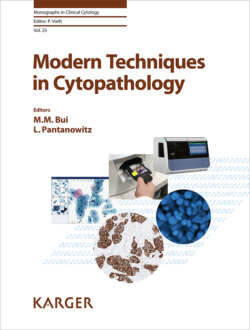Читать книгу Modern Techniques in Cytopathology - Группа авторов - Страница 9
На сайте Литреса книга снята с продажи.
Abstract
ОглавлениеUltrasound-guided fine-needle aspiration (FNA) biopsy allows for accurate sampling of mass lesions. The diagnostic information from this procedure is maximized when the pathologist is intimately involved with specimen procurement, specimen triage, and interpretation. This chapter discusses the role of the interventional cytopathologist, training opportunities, and basic information for starting a pathologist ultrasound-guided FNA clinic.
© 2020 S. Karger AG, Basel
In 2009, the College of American Pathologists began offering a course to cytologists in ultrasound-guided fine-needle aspiration (USFNA) biopsy entitled Ultrasound-Guided Fine-Needle Aspiration Advanced Practical Pathology Program (USFNA AP3). Prior to this, only a handful of cytopathologists were performing their own USFNA biopsies. In less than a decade, cytopathologists have realized the utility of learning and practicing USFNA. The technique is now taught in residency and fellowship programs. Highlighting the importance of USFNA in cytopathology training programs, the July 2015 ACGME and ABP Cytopathology Milestone Project (PC2) cited this skill as a level 4 milestone in cytopathology training. According to this milestone the cytology trainee should have the following competency: “Describes and discusses indications and/or performs ultrasound-guided FNAB and core-needle biopsy” [1].
The scope of practice for clinical cytologists is markedly expanded when USFNA is added to their repertoire. In addition to palpable masses, cytologists have the opportunity to sample non-palpable superficial targets. Sampling of palpable masses is also improved. The cytologist has control over needle gauge, number of passes, area of lesion sampled, and, based on rapid on-site cytologic evaluation (ROSE), specimens can be appropriately triaged for ancillary studies such as cell block, immunocytochemical stains, cultures, flow cytometry, molecular studies, and/or core-needle biopsy. With experience, the cytologist can learn how to correlate ultrasound (US) features of a mass with the cytologic findings and can integrate this information into the cytology report to better guide clinicians in appropriate follow-up care and specialist referral. The ability to link the cytology procedure and report to patient management algorithms is immensely valuable for the patient and can be personally gratifying for the clinical cytopathologist. Cytologist-centered USFNA offers patients streamlined, cost-effective, and personalized care.
ROSE of FNA biopsy specimens helps ensure adequate samples for cytologic interpretation. A downside of ROSE is that either a cytotechnologist or pathologist must be on site in radiology or a clinic where the biopsy is performed, which can be a time-intensive endeavor [2]. Even though reimbursement for ROSE is offered, the reimbursement is low and valuable pathologist time is lost [3]. Additionally, if ROSE is undertaken by a cytotechnologist, critical decisions about triage of the specimen may not be possible. Cytopathologist USFNA is preferred over traditional paradigms in which the biopsy is performed by a non-pathologist because the imaging physician assigned to do the biopsy may not be skilled in USFNA. The physician may not understand the importance of sampling masses in specific areas to optimize the sample and could be resistant to suggestions about where to biopsy for optimum sampling. When not under the purview of a cytopathologist, slide smearing and specimen preparation can be poor when it is done by a person not acutely aware of the fragility of cells. A poor smear can sabotage all other aspects of the FNA procedure; therefore, this seemingly simple part of the process is often undervalued by those not intimately involved with specimen interpretation [4].
